
- SAP Community
- Products and Technology
- Technology
- Technology Blogs by Members
- Web Dynpro ABAP: Display tiff images
- Subscribe to RSS Feed
- Mark as New
- Mark as Read
- Bookmark
- Subscribe
- Printer Friendly Page
- Report Inappropriate Content
In 2007 Thomas Jung wrote a blog ABAP Bitmap Image Processing Class. Thomas' blog contains a lot of excellent information regarding how to fetch, convert, cache and display an image in Web Dynpro ABAP. However, looking into the Web Dynpro ABAP forum it seems that the information has bypassed several ABAP developers. This blog focuses on one image processing only and should be considered a simple step-by-step guide of how to display a tiff image in Web Dynpro ABAP. The image format could be any other format supported by the Internet Graphics Server (IGS).
Displaying a tiff image in Web Dynpro ABAP includes (1) fetching a tiff image, (2) converting it into a browser supported content type using the IGS, (3) caching it on the server, and (4) binding the URL to an image element.
Prerequisite
Make sure that your IGS is up and running, for example by executing program GRAPHICS_IGS_IMGCONV_DEMO. More information can be found on help.sap.com. If your IGS is not up and running, then contact your basis team.
1. Fetch
Fetching, converting, and caching an image is not a typical Web Dynpro component task and should therefore be placed in an assistance class.
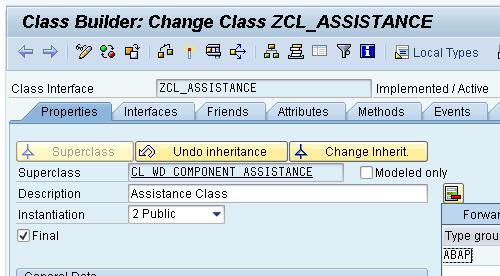
The ZCL_ASSISTANCE class contains four methods, but there could be many more methods. For example, instead of fetching the image via a URL or MIME, the image could be read directly from a Document Management System (DMS).
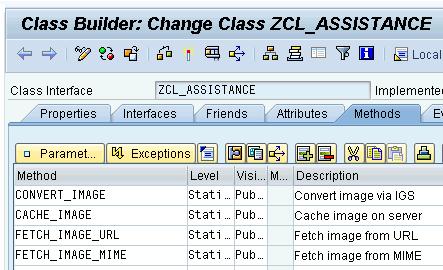
Method FETCH_IMAGE_URL
The FETCH_IMAGE_URL method gets a tiff image from an URL and returns a binary string.
![]()

Implementation of method FETCH_IMAGE_URL.
METHOD fetch_image_url.
"
" References
DATA: lo_client TYPE REF TO if_http_client.
"
" Variables
DATA lv_img_xstring TYPE xstring.
DATA lv_img_string TYPE string.
DATA lv_return_code TYPE i.
DATA lv_error_text TYPE string.
TRY.
" Create the HTTP client
CALL METHOD cl_http_client=>create_by_url
EXPORTING
url = iv_url
IMPORTING
client = lo_client
EXCEPTIONS
argument_not_found = 1
plugin_not_active = 2
internal_error = 3.
IF sy-subrc = 0.
" Set header fields.
CALL METHOD lo_client->request->set_header_field
EXPORTING
name = '~request_method'
value = 'GET'.
CALL METHOD lo_client->request->set_header_field
EXPORTING
name = '~server_protocol'
value = 'HTTP/1.1'.
CALL METHOD lo_client->request->set_header_field
EXPORTING
name = 'Content-Type'
value = 'image/tiff'.
lo_client->send( ).
lo_client->receive( ).
lo_client->response->get_status( IMPORTING code = lv_return_code ).
"get the response as binary data
lv_img_xstring = lo_client->response->get_data( ).
"close connection
lo_client->close( ).
ENDIF. "sy-subrc = 0
CATCH cx_root.
ENDTRY.
rv_xstring = lv_img_xstring.
ENDMETHOD.
Method FETCH_IMAGE_MIME
The FETCH_IMAGE_MIME is very similar to the FETCH_IMAGE_URL method. It gets a tiff image from the MIME repository and returns a binary string.
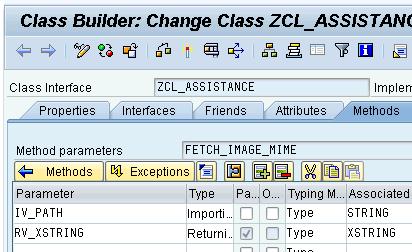
Implementation of method FETCH_IMAGE_MIME.
METHOD fetch_image_mime.
"
" References
DATA lr_mime_repository TYPE REF TO if_mr_api.
"
" Variables
DATA lv_img_xstring TYPE xstring.
TRY.
"MIME repository reference
lr_mime_repository = cl_mime_repository_api=>get_api( ).
"Get file from MIME
CALL METHOD lr_mime_repository->get
EXPORTING
i_url = iv_path
IMPORTING
e_content = lv_img_xstring.
CATCH cx_root.
ENDTRY.
"Return binary representation of file
rv_xstring = lv_img_xstring.
ENDMETHOD.
2. Convert
After fetching the tiff image it should be converted into a browser supported format, as for example jpeg. Method CONVERT_IMAGE uses the fetched image together with the input (tiff) and output (jpeg) format to return a binary representation of the converted image.
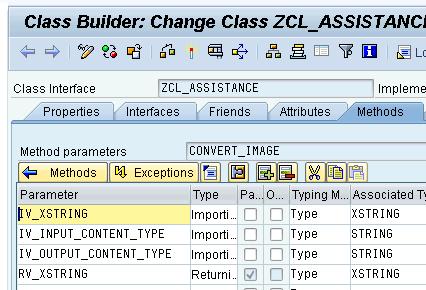
Implementation of method CONVERT_IMAGE.
METHOD convert_image.
"Objects
DATA lo_igs_imgconv TYPE REF TO cl_igs_image_converter.
"Variables
DATA lv_img_blob TYPE w3mimetabtype.
DATA lv_img_size TYPE w3param-cont_len.
DATA lv_img_xstring TYPE xstring.
"Create IGS reference
CREATE OBJECT lo_igs_imgconv.
"input image/tiff, output image/jpeg
lo_igs_imgconv->input = iv_input_content_type.
lo_igs_imgconv->output = iv_output_content_type.
CALL FUNCTION 'SCMS_XSTRING_TO_BINARY'
EXPORTING
buffer = iv_xstring
IMPORTING
output_length = lv_img_size
TABLES
binary_tab = lv_img_blob.
CALL METHOD lo_igs_imgconv->set_image
EXPORTING
blob = lv_img_blob
blob_size = lv_img_size.
CALL METHOD lo_igs_imgconv->execute
EXCEPTIONS
OTHERS = 1.
IF sy-subrc IS INITIAL.
CALL METHOD lo_igs_imgconv->get_image
IMPORTING
blob = lv_img_blob
blob_size = lv_img_size.
CALL FUNCTION 'SCMS_BINARY_TO_XSTRING'
EXPORTING
input_length = lv_img_size
IMPORTING
buffer = lv_img_xstring
TABLES
binary_tab = lv_img_blob
EXCEPTIONS
failed = 1
OTHERS = 2.
ENDIF.
rv_xstring = lv_img_xstring.
ENDMETHOD.
3. Cache
The following method returns a URL of the converted XSTRING. I found the implementation on SDN.
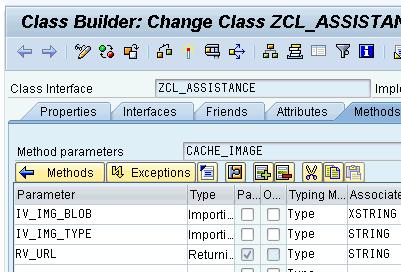
Implementation of CACHE_IMAGE
METHOD cache_image.
DATA lv_url TYPE string.
"Create the cached response object that we will insert our content into
DATA: cached_response TYPE REF TO if_http_response.
CREATE OBJECT cached_response
TYPE
cl_http_response
EXPORTING
add_c_msg = 1.
"cached_response->set_compression(
options = cached_response->IF_HTTP_ENTITY~CO_COMPRESS_IN_ALL_CASES ).
TRY. " ignore, if compression can not be switched on
CALL METHOD cached_response->set_compression
EXPORTING
OPTIONS = cached_response->co_compress_based_on_mime_type
EXCEPTIONS
OTHERS = 1.
CATCH cx_root.
ENDTRY.
"set the data and the headers
cached_response->set_data( iv_img_blob ).
cached_response->set_header_field(
name = if_http_header_fields=>content_type
value = iv_img_type ).
"Set the Response Status
cached_response->set_status( code = 200 reason = 'OK' ).
"Set the Cache Timeout - 30 min
cached_response->server_cache_expire_rel( expires_rel = 1800 ).
"Create a unique URL for the object
DATA: guid TYPE guid_32.
CALL FUNCTION 'GUID_CREATE'
IMPORTING
ev_guid_32 = guid.
CONCATENATE '/usr/sap/public' '/' guid '.' 'jpg' INTO lv_url.
"Cache the URL
cl_http_server=>server_cache_upload(
url = lv_url
response = cached_response ).
"Return URL
rv_url = lv_url.
ENDMETHOD.
4. Display
This section covers how to diplay the converted tiff image in Web Dynpro ABAP. Start by adding the above described assistance class ZCL_ASSISTANCE to the Web Dynpro ABAP component.
Component

The Web Dynpro ABAP object tree will look as follows.

Context
Go to the Context tab and create an IMAGE node.

Create a SOURCE attribute in the IMAGE node.
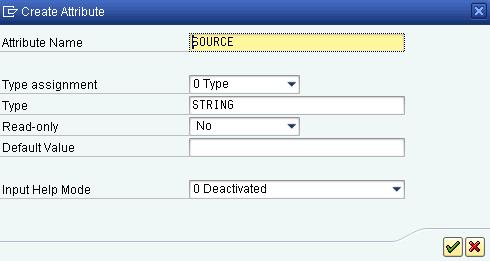
Upon creating the IMAGE node and SOURCE attribute the Context should look as follows.

View
In the view create an image element under the root container.

Bind the image element to the above created context attribute.

Implement the WDDOINIT method.
METHOD wddoinit .
"
"Constants
CONSTANTS lc_input_content_type TYPE string VALUE 'image/tiff'.
CONSTANTS lc_output_content_type TYPE string VALUE 'image/jpeg'.
CONSTANTS lc_path TYPE string
VALUE '/SAP/BC/WebDynpro/SAP/Z_TIF_IMAGE_DISPLAY/TIFF.tif'.
"
"References
DATA lr_node_image TYPE REF TO if_wd_context_node.
"
"Variables
DATA lv_img_xstring TYPE xstring.
DATA lv_img_cache_url TYPE string.
"Fetch IMAGE
lv_img_xstring = wd_assist->fetch_image_mime( lc_path ).
"Convert image
lv_img_xstring = wd_assist->convert_image(
iv_xstring = lv_img_xstring
iv_input_content_type = lc_input_content_type
iv_output_content_type = lc_output_content_type
).
"Cache image
lv_img_cache_url = wd_assist->cache_image(
iv_img_blob = lv_img_xstring
iv_img_type = lc_output_content_type
).
"Set context url
lr_node_image = wd_context->get_child_node( wd_this->wdctx_image ).
lr_node_image->set_attribute(
name = 'SOURCE'
value = lv_img_cache_url ).
ENDMETHOD.
Application
Finally, create an application of the component and test it.
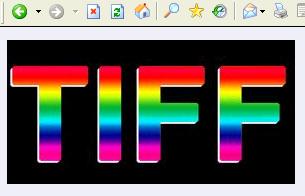
(Image source: wikipedia.org)
- SAP Managed Tags:
- UI Web Dynpro ABAP
You must be a registered user to add a comment. If you've already registered, sign in. Otherwise, register and sign in.
-
"automatische backups"
1 -
"regelmäßige sicherung"
1 -
"TypeScript" "Development" "FeedBack"
1 -
505 Technology Updates 53
1 -
ABAP
14 -
ABAP API
1 -
ABAP CDS Views
2 -
ABAP CDS Views - BW Extraction
1 -
ABAP CDS Views - CDC (Change Data Capture)
1 -
ABAP class
2 -
ABAP Cloud
2 -
ABAP Development
5 -
ABAP in Eclipse
1 -
ABAP Platform Trial
1 -
ABAP Programming
2 -
abap technical
1 -
absl
2 -
access data from SAP Datasphere directly from Snowflake
1 -
Access data from SAP datasphere to Qliksense
1 -
Accrual
1 -
action
1 -
adapter modules
1 -
Addon
1 -
Adobe Document Services
1 -
ADS
1 -
ADS Config
1 -
ADS with ABAP
1 -
ADS with Java
1 -
ADT
2 -
Advance Shipping and Receiving
1 -
Advanced Event Mesh
3 -
AEM
1 -
AI
7 -
AI Launchpad
1 -
AI Projects
1 -
AIML
9 -
Alert in Sap analytical cloud
1 -
Amazon S3
1 -
Analytical Dataset
1 -
Analytical Model
1 -
Analytics
1 -
Analyze Workload Data
1 -
annotations
1 -
API
1 -
API and Integration
3 -
API Call
2 -
Application Architecture
1 -
Application Development
5 -
Application Development for SAP HANA Cloud
3 -
Applications and Business Processes (AP)
1 -
Artificial Intelligence
1 -
Artificial Intelligence (AI)
5 -
Artificial Intelligence (AI) 1 Business Trends 363 Business Trends 8 Digital Transformation with Cloud ERP (DT) 1 Event Information 462 Event Information 15 Expert Insights 114 Expert Insights 76 Life at SAP 418 Life at SAP 1 Product Updates 4
1 -
Artificial Intelligence (AI) blockchain Data & Analytics
1 -
Artificial Intelligence (AI) blockchain Data & Analytics Intelligent Enterprise
1 -
Artificial Intelligence (AI) blockchain Data & Analytics Intelligent Enterprise Oil Gas IoT Exploration Production
1 -
Artificial Intelligence (AI) blockchain Data & Analytics Intelligent Enterprise sustainability responsibility esg social compliance cybersecurity risk
1 -
ASE
1 -
ASR
2 -
ASUG
1 -
Attachments
1 -
Authorisations
1 -
Automating Processes
1 -
Automation
2 -
aws
2 -
Azure
1 -
Azure AI Studio
1 -
B2B Integration
1 -
Backorder Processing
1 -
Backup
1 -
Backup and Recovery
1 -
Backup schedule
1 -
BADI_MATERIAL_CHECK error message
1 -
Bank
1 -
BAS
1 -
basis
2 -
Basis Monitoring & Tcodes with Key notes
2 -
Batch Management
1 -
BDC
1 -
Best Practice
1 -
bitcoin
1 -
Blockchain
3 -
bodl
1 -
BOP in aATP
1 -
BOP Segments
1 -
BOP Strategies
1 -
BOP Variant
1 -
BPC
1 -
BPC LIVE
1 -
BTP
12 -
BTP Destination
2 -
Business AI
1 -
Business and IT Integration
1 -
Business application stu
1 -
Business Application Studio
1 -
Business Architecture
1 -
Business Communication Services
1 -
Business Continuity
1 -
Business Data Fabric
3 -
Business Partner
12 -
Business Partner Master Data
10 -
Business Technology Platform
2 -
Business Trends
4 -
CA
1 -
calculation view
1 -
CAP
3 -
Capgemini
1 -
CAPM
1 -
Catalyst for Efficiency: Revolutionizing SAP Integration Suite with Artificial Intelligence (AI) and
1 -
CCMS
2 -
CDQ
12 -
CDS
2 -
Cental Finance
1 -
Certificates
1 -
CFL
1 -
Change Management
1 -
chatbot
1 -
chatgpt
3 -
CL_SALV_TABLE
2 -
Class Runner
1 -
Classrunner
1 -
Cloud ALM Monitoring
1 -
Cloud ALM Operations
1 -
cloud connector
1 -
Cloud Extensibility
1 -
Cloud Foundry
4 -
Cloud Integration
6 -
Cloud Platform Integration
2 -
cloudalm
1 -
communication
1 -
Compensation Information Management
1 -
Compensation Management
1 -
Compliance
1 -
Compound Employee API
1 -
Configuration
1 -
Connectors
1 -
Consolidation Extension for SAP Analytics Cloud
2 -
Control Indicators.
1 -
Controller-Service-Repository pattern
1 -
Conversion
1 -
Cosine similarity
1 -
cryptocurrency
1 -
CSI
1 -
ctms
1 -
Custom chatbot
3 -
Custom Destination Service
1 -
custom fields
1 -
Customer Experience
1 -
Customer Journey
1 -
Customizing
1 -
cyber security
3 -
Data
1 -
Data & Analytics
1 -
Data Aging
1 -
Data Analytics
2 -
Data and Analytics (DA)
1 -
Data Archiving
1 -
Data Back-up
1 -
Data Governance
5 -
Data Integration
2 -
Data Quality
12 -
Data Quality Management
12 -
Data Synchronization
1 -
data transfer
1 -
Data Unleashed
1 -
Data Value
8 -
database tables
1 -
Datasphere
2 -
datenbanksicherung
1 -
dba cockpit
1 -
dbacockpit
1 -
Debugging
2 -
Delimiting Pay Components
1 -
Delta Integrations
1 -
Destination
3 -
Destination Service
1 -
Developer extensibility
1 -
Developing with SAP Integration Suite
1 -
Devops
1 -
digital transformation
1 -
Documentation
1 -
Dot Product
1 -
DQM
1 -
dump database
1 -
dump transaction
1 -
e-Invoice
1 -
E4H Conversion
1 -
Eclipse ADT ABAP Development Tools
2 -
edoc
1 -
edocument
1 -
ELA
1 -
Embedded Consolidation
1 -
Embedding
1 -
Embeddings
1 -
Employee Central
1 -
Employee Central Payroll
1 -
Employee Central Time Off
1 -
Employee Information
1 -
Employee Rehires
1 -
Enable Now
1 -
Enable now manager
1 -
endpoint
1 -
Enhancement Request
1 -
Enterprise Architecture
1 -
ETL Business Analytics with SAP Signavio
1 -
Euclidean distance
1 -
Event Dates
1 -
Event Driven Architecture
1 -
Event Mesh
2 -
Event Reason
1 -
EventBasedIntegration
1 -
EWM
1 -
EWM Outbound configuration
1 -
EWM-TM-Integration
1 -
Existing Event Changes
1 -
Expand
1 -
Expert
2 -
Expert Insights
2 -
Fiori
14 -
Fiori Elements
2 -
Fiori SAPUI5
12 -
Flask
1 -
Full Stack
8 -
Funds Management
1 -
General
1 -
General Splitter
1 -
Generative AI
1 -
Getting Started
1 -
GitHub
8 -
Grants Management
1 -
groovy
1 -
GTP
1 -
HANA
6 -
HANA Cloud
2 -
Hana Cloud Database Integration
2 -
HANA DB
2 -
HANA XS Advanced
1 -
Historical Events
1 -
home labs
1 -
HowTo
1 -
HR Data Management
1 -
html5
8 -
HTML5 Application
1 -
Identity cards validation
1 -
idm
1 -
Implementation
1 -
input parameter
1 -
instant payments
1 -
Integration
3 -
Integration Advisor
1 -
Integration Architecture
1 -
Integration Center
1 -
Integration Suite
1 -
intelligent enterprise
1 -
iot
1 -
Java
1 -
job
1 -
Job Information Changes
1 -
Job-Related Events
1 -
Job_Event_Information
1 -
joule
4 -
Journal Entries
1 -
Just Ask
1 -
Kerberos for ABAP
8 -
Kerberos for JAVA
8 -
KNN
1 -
Launch Wizard
1 -
Learning Content
2 -
Life at SAP
5 -
lightning
1 -
Linear Regression SAP HANA Cloud
1 -
local tax regulations
1 -
LP
1 -
Machine Learning
2 -
Marketing
1 -
Master Data
3 -
Master Data Management
14 -
Maxdb
2 -
MDG
1 -
MDGM
1 -
MDM
1 -
Message box.
1 -
Messages on RF Device
1 -
Microservices Architecture
1 -
Microsoft Universal Print
1 -
Middleware Solutions
1 -
Migration
5 -
ML Model Development
1 -
Modeling in SAP HANA Cloud
8 -
Monitoring
3 -
MTA
1 -
Multi-Record Scenarios
1 -
Multiple Event Triggers
1 -
Neo
1 -
New Event Creation
1 -
New Feature
1 -
Newcomer
1 -
NodeJS
2 -
ODATA
2 -
OData APIs
1 -
odatav2
1 -
ODATAV4
1 -
ODBC
1 -
ODBC Connection
1 -
Onpremise
1 -
open source
2 -
OpenAI API
1 -
Oracle
1 -
PaPM
1 -
PaPM Dynamic Data Copy through Writer function
1 -
PaPM Remote Call
1 -
PAS-C01
1 -
Pay Component Management
1 -
PGP
1 -
Pickle
1 -
PLANNING ARCHITECTURE
1 -
Popup in Sap analytical cloud
1 -
PostgrSQL
1 -
POSTMAN
1 -
Process Automation
2 -
Product Updates
4 -
PSM
1 -
Public Cloud
1 -
Python
4 -
Qlik
1 -
Qualtrics
1 -
RAP
3 -
RAP BO
2 -
Record Deletion
1 -
Recovery
1 -
recurring payments
1 -
redeply
1 -
Release
1 -
Remote Consumption Model
1 -
Replication Flows
1 -
research
1 -
Resilience
1 -
REST
1 -
REST API
1 -
Retagging Required
1 -
Risk
1 -
Rolling Kernel Switch
1 -
route
1 -
rules
1 -
S4 HANA
1 -
S4 HANA Cloud
1 -
S4 HANA On-Premise
1 -
S4HANA
3 -
S4HANA_OP_2023
2 -
SAC
10 -
SAC PLANNING
9 -
SAP
4 -
SAP ABAP
1 -
SAP Advanced Event Mesh
1 -
SAP AI Core
8 -
SAP AI Launchpad
8 -
SAP Analytic Cloud Compass
1 -
Sap Analytical Cloud
1 -
SAP Analytics Cloud
4 -
SAP Analytics Cloud for Consolidation
3 -
SAP Analytics Cloud Story
1 -
SAP analytics clouds
1 -
SAP BAS
1 -
SAP Basis
6 -
SAP BODS
1 -
SAP BODS certification.
1 -
SAP BTP
21 -
SAP BTP Build Work Zone
2 -
SAP BTP Cloud Foundry
6 -
SAP BTP Costing
1 -
SAP BTP CTMS
1 -
SAP BTP Innovation
1 -
SAP BTP Migration Tool
1 -
SAP BTP SDK IOS
1 -
SAP Build
11 -
SAP Build App
1 -
SAP Build apps
1 -
SAP Build CodeJam
1 -
SAP Build Process Automation
3 -
SAP Build work zone
10 -
SAP Business Objects Platform
1 -
SAP Business Technology
2 -
SAP Business Technology Platform (XP)
1 -
sap bw
1 -
SAP CAP
2 -
SAP CDC
1 -
SAP CDP
1 -
SAP CDS VIEW
1 -
SAP Certification
1 -
SAP Cloud ALM
4 -
SAP Cloud Application Programming Model
1 -
SAP Cloud Integration for Data Services
1 -
SAP cloud platform
8 -
SAP Companion
1 -
SAP CPI
3 -
SAP CPI (Cloud Platform Integration)
2 -
SAP CPI Discover tab
1 -
sap credential store
1 -
SAP Customer Data Cloud
1 -
SAP Customer Data Platform
1 -
SAP Data Intelligence
1 -
SAP Data Migration in Retail Industry
1 -
SAP Data Services
1 -
SAP DATABASE
1 -
SAP Dataspher to Non SAP BI tools
1 -
SAP Datasphere
10 -
SAP DRC
1 -
SAP EWM
1 -
SAP Fiori
2 -
SAP Fiori App Embedding
1 -
Sap Fiori Extension Project Using BAS
1 -
SAP GRC
1 -
SAP HANA
1 -
SAP HCM (Human Capital Management)
1 -
SAP HR Solutions
1 -
SAP IDM
1 -
SAP Integration Suite
9 -
SAP Integrations
4 -
SAP iRPA
2 -
SAP Learning Class
1 -
SAP Learning Hub
1 -
SAP Odata
2 -
SAP on Azure
1 -
SAP PartnerEdge
1 -
sap partners
1 -
SAP Password Reset
1 -
SAP PO Migration
1 -
SAP Prepackaged Content
1 -
SAP Process Automation
2 -
SAP Process Integration
2 -
SAP Process Orchestration
1 -
SAP S4HANA
2 -
SAP S4HANA Cloud
1 -
SAP S4HANA Cloud for Finance
1 -
SAP S4HANA Cloud private edition
1 -
SAP Sandbox
1 -
SAP STMS
1 -
SAP successfactors
3 -
SAP SuccessFactors HXM Core
1 -
SAP Time
1 -
SAP TM
2 -
SAP Trading Partner Management
1 -
SAP UI5
1 -
SAP Upgrade
1 -
SAP Utilities
1 -
SAP-GUI
8 -
SAP_COM_0276
1 -
SAPBTP
1 -
SAPCPI
1 -
SAPEWM
1 -
sapmentors
1 -
saponaws
2 -
SAPS4HANA
1 -
SAPUI5
4 -
schedule
1 -
Secure Login Client Setup
8 -
security
9 -
Selenium Testing
1 -
SEN
1 -
SEN Manager
1 -
service
1 -
SET_CELL_TYPE
1 -
SET_CELL_TYPE_COLUMN
1 -
SFTP scenario
2 -
Simplex
1 -
Single Sign On
8 -
Singlesource
1 -
SKLearn
1 -
soap
1 -
Software Development
1 -
SOLMAN
1 -
solman 7.2
2 -
Solution Manager
3 -
sp_dumpdb
1 -
sp_dumptrans
1 -
SQL
1 -
sql script
1 -
SSL
8 -
SSO
8 -
Substring function
1 -
SuccessFactors
1 -
SuccessFactors Platform
1 -
SuccessFactors Time Tracking
1 -
Sybase
1 -
system copy method
1 -
System owner
1 -
Table splitting
1 -
Tax Integration
1 -
Technical article
1 -
Technical articles
1 -
Technology Updates
14 -
Technology Updates
1 -
Technology_Updates
1 -
terraform
1 -
Threats
1 -
Time Collectors
1 -
Time Off
2 -
Time Sheet
1 -
Time Sheet SAP SuccessFactors Time Tracking
1 -
Tips and tricks
2 -
toggle button
1 -
Tools
1 -
Trainings & Certifications
1 -
Transport in SAP BODS
1 -
Transport Management
1 -
TypeScript
2 -
ui designer
1 -
unbind
1 -
Unified Customer Profile
1 -
UPB
1 -
Use of Parameters for Data Copy in PaPM
1 -
User Unlock
1 -
VA02
1 -
Validations
1 -
Vector Database
2 -
Vector Engine
1 -
Visual Studio Code
1 -
VSCode
1 -
Web SDK
1 -
work zone
1 -
workload
1 -
xsa
1 -
XSA Refresh
1
- « Previous
- Next »
- ABAP Cloud Developer Trial 2022 Available Now in Technology Blogs by SAP
- List Report Chart Does Not Display When Sorting - RAP in Technology Q&A
- Deliver Real-World Results with SAP Business AI: Q4 2023 & Q1 2024 Release Highlights in Technology Blogs by SAP
- Harnessing Generative AI Capabilities with SAP HANA Cloud Vector Engine - Part 1 [Architecture] in Technology Blogs by SAP
- How to use <img> tag in FormattedText or FeedlistItem in Technology Q&A
| User | Count |
|---|---|
| 8 | |
| 5 | |
| 5 | |
| 4 | |
| 4 | |
| 3 | |
| 3 | |
| 3 | |
| 3 | |
| 3 |